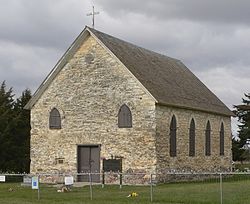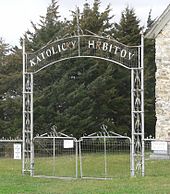
Clay County is a county in the U.S. state of South Dakota. As of the 2020 census, the population was 14,967. The county seat is Vermillion, which is also home to the University of South Dakota. The county is named for Henry Clay, American statesman, US Senator from Kentucky, and United States Secretary of State in the 19th century.

Bon Homme County is a county in the U.S. state of South Dakota. As of the 2020 census, the population was 7,003. Its county seat is Tyndall.

Yankton is a city in and the county seat of Yankton County, South Dakota, United States.
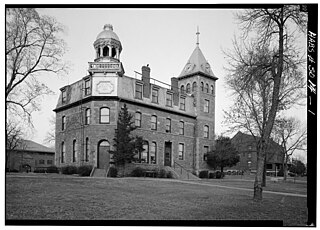
Yankton College was a private liberal arts college in Yankton, South Dakota, United States, affiliated with the Congregational Christian Churches. Yankton College produced nine Rhodes Scholars, more than any other South Dakota higher education institution, and a United States Senator.
Frank M. Ziebach was a political figure in the Dakota Territory during the territorial period from 1861 to 1889. He was a pioneer newspaperman, founding a number of newspapers in the Iowa and Dakota Territories, including the Yankton "Weekly Dakotan" in 1861, which is still published today as the Yankton "Press and Dakotan". He was known as the "squatter governor" of the Dakota Territory. Ziebach County, South Dakota was created in 1911, and is named for him.

The Cake Theater is a historic building on Veterans Square in Laconia, New Hampshire, United States. Built in 1836 and extensively restyled in 1871, it is a fine 19th-century building, illustrating adaptive alterations made over time to reflect changing uses and tastes. The building was listed on the National Register of Historic Places in 1985.[1]

United Baptist Church of Lakeport is a historic church at 35 Park Street in the village of Lakeport in Laconia, New Hampshire, United States. Built in 1891 after a fire destroyed an older church, it is an eclectic local example of Late Victorian architecture. It was listed on the National Register of Historic Places in 1985.

Bartlett Tripp was a diplomat, Chief Justice of the Dakota Territory Supreme Court, first professor of the University of South Dakota College of Law and first President of the South Dakota Bar Association.
Peter C. Shannon was an American lawyer, politician, and judge. After practicing law for a time in Pittsburgh, Pennsylvania, in 1852, Shannon ran unsuccessfully for a seat in the US House of Representatives, losing by five hundred votes to Whig David Ritchie. Shannon was then appointed president judge of the local district court in 1852 by Pennsylvania Governor William Bigler, but served for only a year, having been defeated for re-election in 1853. At the beginning of the Civil War Shannon became a Republican and was elected to the Pennsylvania House of Representatives, serving two terms, 1862 and 1863. He was commissioned Lieutenant Colonel in a regiment which he helped raise, but resigned to continue his political career. In 1862 he campaigned with Governor Andrew Curtin in his successful re-election bid, and in 1864 was part of Lincoln's re-election campaign in Pennsylvania.

St. John the Baptist Catholic Church is a historic church, with an associated rectory, school, and cemetery, located at 324 S. Washington Avenue in Hubbardston, Michigan. The church was built in 1868. It was added to the National Register of Historic Places and listed as a Michigan State Historic Site in 2001. The parish is clustered with St. Mary parish in Carson City, Michigan.
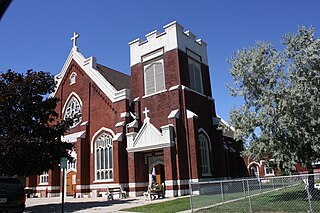
St. John the Baptist Catholic Church, now used as the Menominee County Historical Museum, is a historic church at 904 11th Avenue in Menominee, Michigan. It was added to the National Register of Historic Places in 1995 and designated a Michigan State Historic Site in 1981.

St. Wenceslaus Parish is a Catholic parish of the Roman Catholic Diocese of Sioux Falls in Tabor, South Dakota in the Midwestern United States. Its historic red brick church, built in 1898, was listed as St. Wenceslaus Catholic Church and Parish House on the National Register of Historic Places on December 13, 1984, as part of a "Thematic Nomination of Czech Folk Architecture of Southeastern South Dakota".
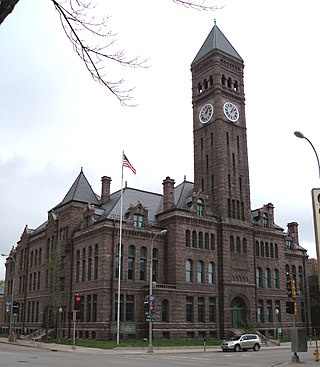
Wallace L. Dow (1844-1911), often known as W. L. Dow, was an architect of Sioux Falls, South Dakota. He has been referred to as the "Builder on the Prairie" and was "considered the premier architect of South Dakota in the late 19th century."
St. Mary's Church, School and Convent is a historic Roman Catholic church complex off United States Route 212 in Zell, South Dakota.

St. Peter's Catholic Church is a parish of the Diocese of Sioux Falls based in Jefferson, South Dakota. Its church building at 400 Main Street was built in 1891 and was added to the National Register of Historic Places in 1989.

The St. Agnes Church is a congregation of the Roman Catholic Church in Utica, South Dakota, operated as a mission of the parish of St. John the Baptist in Lesterville, both in the Diocese of Sioux Falls. It is noted for its historic Gothic Revival church, sometimes known as the Sigel Church after the former name of the area, which was built in the 1890s and added to the National Register of Historic Places in 1980.

Czech South Dakotans are residents of the state of South Dakota who are of Czech ancestry. The Czech language is the seventh most common language spoken in South Dakota, with 645 speakers.

The Ossian Wilbur Goss Reading Room is a historic library building at 188 Elm Street in the Lakeport section of Laconia, New Hampshire. The architecturally eclectic single-story brick building was designed by Boston architect Willard P. Adden and built in 1905-06 after the collection of the former Lakeport library was moved to the recently built Gale Memorial Library in the center of Laconia. Its construction was funded by a bequest from Ossian Wilbur Goss, a local doctor who had died without natural heirs. The building officially became a branch of the Laconia library system in 1909, and continues to be administered in part by trustees of Goss's legacy. The building was listed on the National Register of Historic Places in 1986.
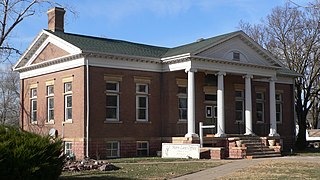
The Yankton Carnegie Library is a historic building in Yankton, South Dakota. It was built as a Carnegie library in 1902–03, and is Neoclassical style in style. It was built by German-born contractor August Goetz. It was a public library from 1903 to 1973.
August Goetz was a building contractor based in Yankton, South Dakota who is credited with constructing many churches, public buildings, and houses throughout the state. Several of his works are listed on the National Register of Historic Places (NRHP).
